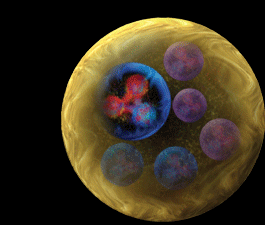Transparent Nuclei

An electron (bright green) has just scattered from a nucleus and created a pion (green-skinned particle). This pion's quarks are so tightly packed that they nearly cancel each other's color charge, allowing the pion to slip through the nucleus without interacting, an effect now seen at the lowest possible energies.
Image Credit: J. Griffin / Jefferson Lab
A two-quark particle shot into a large nucleus is ordinarily absorbed, as its quarks interact with the nuclear quarks. But in some cases it can sail right through. Now a research team has reported that they have observed this so-called color transparency in the lower energy realm, where such quark-scale effects aren't normally seen. The results—which are somewhat controversial—could help theorists who hope to bring the clean calculations of high energy, particle physics down into the messy world of lower energy nuclear physics.
Read more about this research at http://focus.aps.org/story/v20/st22
Text courtesy of Physical Review Focus.











